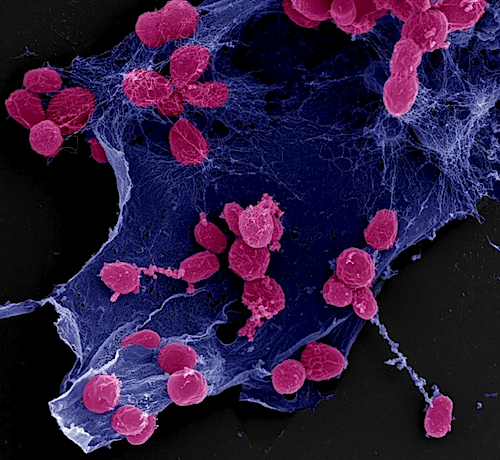|
|
Developmental Biology - Ocean Biofilms Offer New Subtances
Ocean Bacteria Can Have a Green Thumb
Bacterial biofilms floating on our oceans harvest other bacteria for food, and may produce an antibiotic useful to humans...
The sheer expanse of our oceans present a hostile enviornment for bacteria. Tiny, bacteria have little chance of finding enough food to survive simply floating over earth's collection of oceans and seas. However, they do find everything they need on the surfaces of aquatic plants and algae — biofilms floating along with them.
Various bacterial species grow in complex biofilm communities in the oceans, and these bacterial communities exchange information, even offering each other protection.
Now, microbiologists have identified a new type of bacteria: planktomycete, which produce bioactive natural products humans can use.
University of Jena, Germany, microbiologists working with Prof. Christian Jogler just discovered these natural products, finding they control the composition of other biofilms and produce outcomes that serve their own bacterial colony's specific needs. They cultivate other bacterial colonies much like gardeners. Scientists from Germany and the Netherlands presented their findings in the journal Communications Biology.
Planctomycetes Produce Bioactive Natural Substances
The bacterium Stieleria maiorica is one of nearly 80 newly discovered bacterial species found by Friedrich-Schiller University (Jena, Germany) along with researchers from the Netherlands. These scientists cultivate fresh and saltwater samples of bacterial life from all over the oceans examining various species.
Stieleria maiorica is a planctomycete fished out of the Mediterranean Sea off the coast of Majorca. Researchers are particularly interested in planctomycetes as they suspect they contain naturally produced bioactive products. Jena scientists have now found a previously unknown group of chemical compounds they named "stieleriacine" after a bacterium of the same name.
"These are relatively small molecules structurally similar to a well known group of signals molecular microorganisms use to communicate with each other. Leading to the assumption these stieleriacines also act as signalling molecules in the broadest sense."
Christian Jogler PhD, Professor, Institute of Microbiology, Friedrich Schiller University, Jena, Germany.
Bacteria Release Antibiotics After Receiving Chemical Signals
Looking for how other bacterial species react to stieleriacines produced by planctomycetes - scientists observed the species Roseobacter react to stieleriacine signals. Like planctomycetes, these microorganisms also live on aquatic plants and algae and compete with the planctomycetes for habitat and nutrients.
Stieleriacines promote the growth of some Roseobacter species, but inhibit others.
What's more, species that grow better as a result of these chemical signals also produce an antibiotic which they release into their environment.
Roseobacter species that are inhibited in their growth by stieleriacine signals do not produce an antibiotic.
"This is a crucial advantage for planctomycetes. They are resistant to antibiotic. Other species of bacteria, however, that compete with planctomycetes in the biofilm, are inhibited by that antibiotic.
One could say that planctomycetes use the Roseobacter for the 'heavy manual work' of adapting the composition of the biofilm to their own requirements and, like skilled gardeners, for regulating the growth of other species."
Christian Jogler PhD
This gives the rather slow-growing planctomycetes a chance to compete with bacterial species that would otherwise make things difficult for them.
Signalling Modulate Biofilm Composition
For Prof. Jogler and his colleagues in the Cluster of Excellence "Balance of the Microverse" at Jena University, planctomycetes are still of interest — and not only as skilful underwater landscape gardeners.
"The chemical signalling substances that microorganisms use to communicate and influence their environment, could also be of use in infection research," says Jogler.
If small molecules can be used to modify the composition of biofilms, they could be useful in preventing pathogenic microorganisms from settling on the surfaces of catheters or implants - for example.
With this study, the authors confirmed their hypothesis that the oceans are full of new substances. Possibly even new antibiotics. Making it worth taking a look below the surface of the water to find biocompatible substances in biofilms of aquatic plants and algae.
Abstract
Bacterial strains of the phylum Planctomycetes occur ubiquitously, but are often found on surfaces of aquatic phototrophs, e.g. alga. Despite slower growth, planctomycetes are not outcompeted by faster-growing bacteria in biofilms on such surfaces; however, strategies allowing them to compensate for slower growth have not yet been investigated. Here, we identified stieleriacines, a class of N-acylated tyrosines produced by the novel planctomycete Stieleria maiorica Mal15T, and analysed their effects on growth of the producing strain and bacterial species likely co-occurring with strain Mal15T. Stieleriacines reduced the lag phase of Mal15T and either stimulated or inhibited biofilm formation of two bacterial competitors, indicating that Mal15T employs stieleriacines to specifically alter microbial biofilm composition. The genetic organisation of the putative stieleriacine biosynthetic cluster in strain Mal15T points towards a functional link of stieleriacine biosynthesis to exopolysaccharide-associated protein sorting and biofilm formation.
Authors
Nicolai Kallscheuer, Olga Jeske, Birthe Sandargo, Christian Boedeker, Sandra Wiegand, Pascal Bartling, Mareike Jogler, Manfred Rohde, Jörn Petersen, Marnix H. Medema, Frank Surup and Christian Jogler.
Acknowledgements
The authors especially thank Anja Heuer and Cäcilia Bergmann, Wera Collisi, Christel Kakoschke, Simone Severitt and Nicole Heyer for excellent technical assistance. We further thank Cathrin Spröer for general support during sequencing, Daniela Borchert for help with time-lapse microscopy and Marc Stadler for generous support. This work was funded by the Deutsche Forschungsgemeinschaft DFG JO 893/4-1, SU 936/1-1, TRR 51 and KA 4967/1-1.
Return to top of page.
|
|
Jun 18 2020 Fetal Timeline Maternal Timeline News
 Scanning electron microscope image of Stieleria maiorica. Cells in PINK. Matrix in BLUE. CREDIT Manfred Rohde/HZI Braunschweigt
|
|

